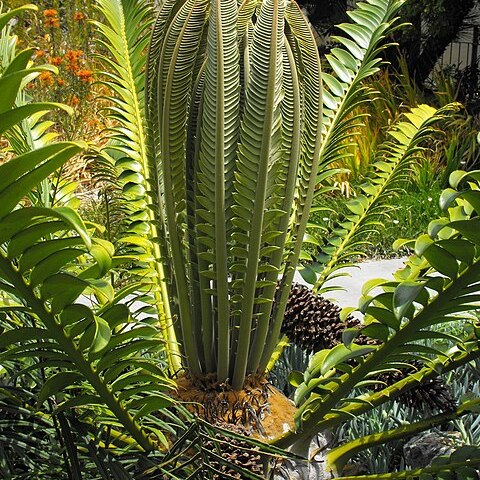Plant generally unbranched, occasionally branched after injury to crown, maximum height about 13 m (35-40 ft, many between 4.6-7.6 m), 40-45 cm diam., apex of stem with some brown wool. Leaves 1-2.5 m long with fairly short petiole, densely tomentose at first, glabrescent, except for pulvinus; rhachis mainly straight, recurving towards apex; leaflets spreading-recurved more or less at right angles to rhachis, upper ones often somewhat overlapping, reduced in size towards apex and to several prickles at base; median leaflets lanceolate to ovate-lanceolate, sometimes slightly falcate, 10-20 cm long, 2-3.5 cm broad, smooth on upper surface, with unevenly prominent veins on lower surface, remotely 2-5-toothed on upper margin towards base of leaflet, 1-3-toothed on lower margin, with pungent apex. Cones 2-4 together on short stout tomentose peduncles. Male cones subcylindric, 30-40 cm long, 13-15 cm diam., obtusely rounded at base and apex; median scales 4-4.5 cm long, 2.5 cm broad with sharp lateral ridges; bulla face projecting 1-1.5 cm, with deciduous reddish hairs, upper and lower facets variably slightly angled, terminal facet 1.5-1.6 broad, 8-13 mm wide vertically. Female cones oblong-oval in outline, 50-80 cm long, 20-30 cm diam.; median scales about 8 cm long, 6-7 cm broad, 3-4 cm thick vertically; bulla face projecting about 2.5 cm with fairly acute lateral ridges extending into the incurved lateral lobes 1-2 cm long, slightly verrucose to nearly smooth on exposed portion, upper and lower facets rounded with slight ridging, terminal facet thinly fawn-tomentose, 1.5-2 cm broad, 1-1.5 cm wide vertically. Seed red, angled by compression, 4.5-5 cm long, 2.5 cm diam., with fleshy beak.
More
A tall plant. It grows to 12 m tall. The trunk is thick and scarred. It has a netted pattern. The crown is made up of shiny straight leaves. The leaves are spiny and up to 2.4 m long. The leaflets are broad; the middle one being 3 cm wide. They are often slightly curved and have teeth along the edges. The fruit occur as cones. 2 to 4 cones occur together. They are large and the female cones are the biggest. They can be 80 cm long and weigh 34 kg, They occur in the heart of the big green leaves. The seed are orange red. The thin fully ripe flesh around the seed is edible.
Plant generally unbranched. Stems up to 13 m high. Leaves up to 2.5 m long, glossy, dark olive-green above, matt yellowish green below, with contrasting yellow rhachises. Leaflets spreading-recurved from rhachis, lanceolate to ovate-lanceolate, sometimes falcate, 100-200 x 20-35 mm, toothed with a pungent apex.
The fully ripe flesh around the seeds is eaten, especially by children. The stem is cut into slices and buried until it becomes partly fermented then it is sliced and sun dried before crushing into flour. This is eaten after boiling. CAUTION: The seed kernel is poisonous.


